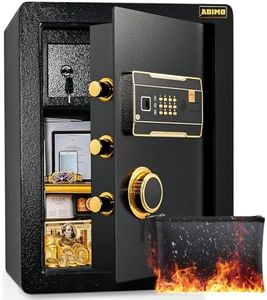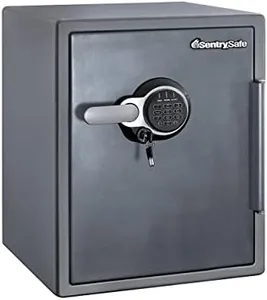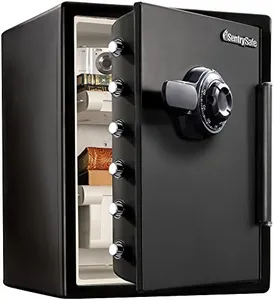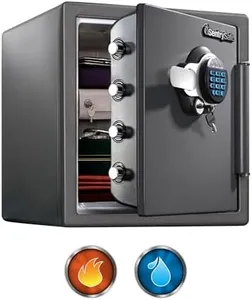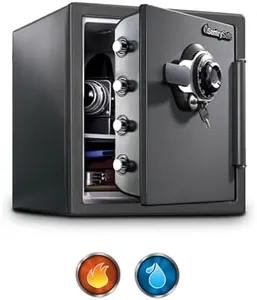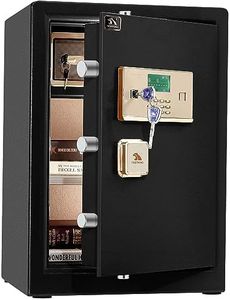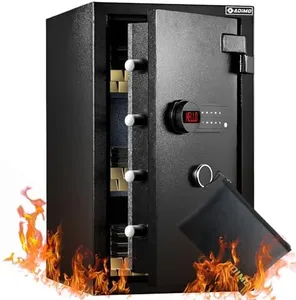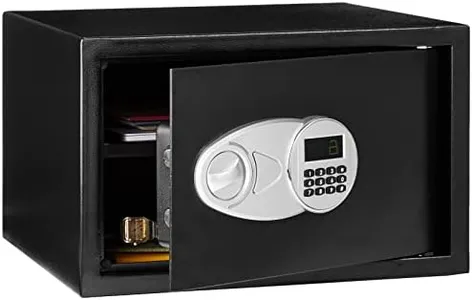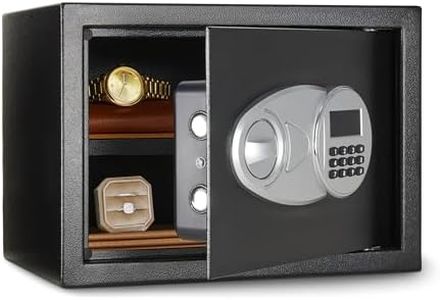10 Best Home Safes 2025 in the United States
Our technology thoroughly searches through the online shopping world, reviewing hundreds of sites. We then process and analyze this information, updating in real-time to bring you the latest top-rated products. This way, you always get the best and most current options available.

Our Top Picks
Winner
SentrySafe Fireproof and Waterproof Gray Steel Home Safe with Digital Keypad Lock, Floor Safe with Interior Lighting Secures Money, Documents, 2.05 Cubic Feet, SFW205GQC
Most important from
9660 reviews
The SentrySafe Fireproof and Waterproof Gray Steel Home Safe is a robust option for anyone looking to secure valuables at home. With a spacious capacity of 2.05 cubic feet, it offers ample room for important documents, cash, and other personal items. Its fireproof rating allows it to withstand temperatures of up to 1700°F for an hour, ensuring that your irreplaceable items remain safe in a fire. Plus, it’s ETL verified to survive a 15-foot drop, which adds to its reliability during emergencies.
Water resistance is another strong feature, providing up to 24 hours of protection in water depths of 8 inches. This makes it a reliable choice for those in flood-prone areas. The construction material is sturdy alloy steel, complemented by a pry-resistant hinge bar and 6 live-locking bolts, which enhance security.
One of the highlights is the customizable digital combination lock, along with a backup key, giving flexibility in how you access the safe. Additionally, the interior lighting ensures visibility, making it easier to locate your items in low light. While the safe is impressive, it requires careful handling due to its weight and size. Its door needs 17.5 inches of clearance to open fully, which might be a factor in tighter spaces. The touchpad control, while convenient, could pose challenges if batteries fail, although a backup key mitigates this risk.
For those looking for a durable and secure home safe, especially for protecting important documents and valuables from fire and water damage, the SentrySafe model is a strong contender. However, potential buyers should ensure they have adequate space and consider the implications of the electronic lock.
Most important from
9660 reviews
SentrySafe Black Fireproof Waterproof Floor Safe with Dial Combination Lock for Home or Office, 2.05 Cubic Feet, SFW205CWB
Most important from
5597 reviews
The SentrySafe Black Fireproof Waterproof Floor Safe, model SFW205CWB, offers robust protection for home or office use with its combination of size, security, and durability. Its 2.05 cubic feet capacity is ample for storing important documents, valuables, and digital media. The safe is UL Classified to withstand fire for up to 1 hour at temperatures of 1700°F, and it is ETL Verified to survive a 15-foot fall during a fire. Additionally, it offers 24-hour water protection in up to 8 inches of water, providing peace of mind during floods.
The fixed dial combination lock enhances security, complemented by six live-locking bolts and a pry-resistant hinge bar. Constructed from alloy steel, the safe is sturdy and comes with bolt-down hardware for secure floor mounting. However, at 124.8 pounds, it is quite heavy, which might make installation challenging. The fixed combination lock, while secure, might not be as convenient as digital locks for some users.
Despite these minor drawbacks, the SentrySafe SFW205CWB is highly rated by customers for its reliable protection against fire and water, making it a solid choice for safeguarding important items.
Most important from
5597 reviews
SentrySafe Waterproof and Fireproof Alloy Steel Digital Safe Box for Home with Code Button Keypad, 1.23 Cubic Feet, 17.8 x 16.3 x 19.3 Inches (exterior), SFW123GDC
Most important from
9660 reviews
The SentrySafe Waterproof and Fireproof Alloy Steel Digital Safe Box is designed to offer robust protection for your valuables at home. It boasts impressive fire resistance, being UL Classified to endure temperatures of up to 1700°F for an hour, ensuring your documents and valuables stay safe. Additionally, its waterproof capability is ETL Verified, providing up to 24 hours of protection in water depths of 8 inches, which is a great feature for those living in flood-prone areas.
In terms of size and capacity, it offers 1.23 cubic feet of storage, which is adequate for keeping essential items like documents, USBs, and smaller valuables. The dimensions make it versatile for various storage locations, although it does require some clearance to fully open the door. The safe's construction from alloy steel enhances durability and features like pry-resistant hinges and live-locking bolts contribute to its security.
One of the strong points is the digital combination lock, which allows you to set your own code, providing an additional layer of security. The inclusion of a secondary locking key is a thoughtful touch for those who prefer extra safeguards. However, it’s important to note that the safe relies on four AAA batteries for operation, which means you will need to keep track of battery health to ensure continual access. This SentrySafe model is ideal for homeowners seeking a reliable option for safeguarding important items against fire and water damage. Just be mindful of its weight and the need for battery maintenance, and it should serve you well.
Most important from
9660 reviews
Buying Guide for the Best Home Safes
When choosing a home safe, it's important to consider what you will be storing in it and the level of protection you need. Home safes come in various sizes, materials, and with different locking mechanisms. Understanding the key specifications will help you make an informed decision and ensure that your valuables are well-protected.FAQ
Most Popular Categories Right Now
